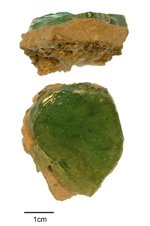Glastonbury Abbey excavations reveal Saxon glass industry
Release Date 08 May 2012

New research led by the University of Reading has revealed that finds at Glastonbury Abbey provide the earliest archaeological evidence of glass-making in Britain.
Professor Roberta Gilchrist, from the Department of Archaeology, has re-examined the records of excavations that took place at Glastonbury in the 1950s and 1960s.
Glass furnaces recorded in 1955-7 were previously thought to date from before the Norman Conquest. However, radiocarbon dating has now revealed that they date approximately to the 680s, and are likely to be associated with a major rebuilding of the abbey undertaken by King Ine of Wessex. Glass-making at York and Wearmouth is recorded in historical documents in the 670s but Glastonbury provides the earliest and most substantial archaeological evidence for glass-making in Saxon Britain.
The extensive remains of five furnaces have been identified, together with fragments of clay crucibles and glass for window glazing and drinking vessels, mainly of vivid blue-green colour. It is likely that specialist glassworkers came from Gaul (France) to work at Glastonbury. The glass will be analysed chemically to provide further information on the sourcing and processing of materials.
Professor Gilchrist said: "Glastonbury Abbey is a site of international historical importance but until now the excavations have remained unpublished. The research project reveals new evidence for the early date of the monastery at Glastonbury and charts its development over one thousand years, from the 6th century to its dissolution in the 16th century."
An exhibition at Glastonbury Abbey Museum, ‘From Fire & Earth', tells the story of the Abbey's pioneering role in medieval crafts and technology, and runs until 16 September 2012.
The full archive of excavations will be brought to publication by Professor Gilchrist, in partnership with the Trustees of Glastonbury Abbey and funded by the Arts and Humanities Research Council. Radiocarbon dating was funded by the Somerset Archaeology & Natural History Society and the Society for Medieval Archaeology. Specialist analyses of the glass are being undertaken by Dr Hugh Willmott (University of Sheffield) and Dr Kate Welham (University of Bournemouth).
ENDS
For more information please contact Rona Cheeseman, research communications manager, on 0118 378 7388 or email r.cheeseman@reading.ac.uk
Follow us on Twitter | Like us on Facebook | Read our research blog 'The Forum'
Notes to editors
The University of Reading has been awarded the Queen's Anniversary Prize 2009 in recognition of the excellence of the University's Department of Archaeology, which, uniquely within the study of archaeology, combines ground-breaking research, enterprise and teaching.
Staff research interests focus on European and Mediterranean archaeology from early prehistory to the later medieval period, and on social archaeology, environmental archaeology and geoarchaeology. Undergraduate and postgraduate courses are wide-ranging and include archaeological science, theory and practical experience of archaeology in the field through our training excavation of the Roman town of Silchester